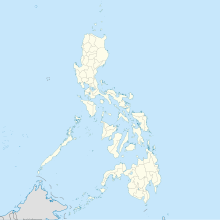Ninoy Aquino International Airport
|
Ninoy Aquino International Airport Paliparang Pandaigdig ng Ninoy Aquino |
|||||||||||||||
|---|---|---|---|---|---|---|---|---|---|---|---|---|---|---|---|
 |
|||||||||||||||
 |
|||||||||||||||
| Summary | |||||||||||||||
| Airport type | Public | ||||||||||||||
| Owner | Government of the Philippines | ||||||||||||||
| Operator | Manila International Airport Authority | ||||||||||||||
| Serves | Greater Manila Area | ||||||||||||||
| Location | Parañaque and Pasay, Metro Manila, Philippines | ||||||||||||||
| Hub for | |||||||||||||||
| Time zone | PHT (UTC+08:00) | ||||||||||||||
| Elevation AMSL | 23 m / 75 ft | ||||||||||||||
| Coordinates | 14°30′31″N 121°01′10″E / 14.50861°N 121.01944°ECoordinates: 14°30′31″N 121°01′10″E / 14.50861°N 121.01944°E | ||||||||||||||
| Website | www.miaa.gov.ph | ||||||||||||||
| Maps | |||||||||||||||
 Map of Ninoy Aquino International Airport Complex |
|||||||||||||||
| Location in the Philippines | |||||||||||||||
| Runways | |||||||||||||||
|
|||||||||||||||
| Statistics (2015) | |||||||||||||||
|
|||||||||||||||
| Passengers | 36,681,601 |
|---|---|
| Total international flights (2015) | 87,629 |
| Total domestic flights (2015) | 149,421 |
| Cargo (2015) (in metric tons) | 460,135.15 |
| Terminal Buildings | ||
|---|---|---|
| Total | ||
| Area | 205,500 square metres (2,212,000 sq ft) | |
| Handling capacity | 28 million passengers | |
| Jet bridges | 64 (aerobridge) 20 (contact) |
|
| Terminal 1 | ||
| Completion | 1981 | |
| Opened | April 2, 1982 | |
| Area | 67,000 square metres (720,000 sq ft) | |
| Handling capacity | 6 million passengers | |
| Jet bridges | 18 (aerobridge) | |
| Terminal 2 (Centennial Terminal) | ||
| Completion | December 28, 1998 | |
| Opened | May 1, 1999 | |
| Area | 75,000 square metres (810,000 sq ft) | |
| Handling capacity | 9 million passengers | |
| Jet bridges | 12 (aerobridge) | |
| Terminal 3 | ||
| Opened | July 22, 2008 (partial) August 1, 2014 (full) |
|
| Area | 189,000 square metres (2,030,000 sq ft) | |
| Handling capacity | 13 million passengers | |
| Jet bridges | 34 (aerobridge) 20 (contact) |
|
| Terminal 4 (Manila Domestic Passenger Terminal) | ||
| Built | 1948 | |
| Handling capacity | 1000 passengers | |
| Jet bridges | 0 (passengers are bussed) | |
| Terminal 5 (Budget Terminal) | ||
| Status | Planning and design stages | |
| Area | TBA | |
| Handling capacity | TBA | |
| Jet bridges | TBA | |
The Ninoy Aquino International Airport (Filipino: Paliparang Pandaigdig ng Ninoy Aquino) or NAIA /ˈnaɪ.ə/, also known as Manila International Airport (IATA: MNL, ICAO: RPLL), is the airport serving Manila and its surrounding metropolitan area. Located along the border between the cities of Pasay and Parañaque, about 7 kilometres (4.3 mi) south of Manila proper and southwest of Makati, NAIA is the main international gateway for travelers to the Philippines and serves as a hub for AirAsia Philippines, Cebgo, Cebu Pacific, PAL Express, and Philippine Airlines. It is managed by the Manila International Airport Authority (MIAA), a branch of the Department of Transportation (DOTr).
Officially, NAIA is the only airport serving the Manila area. However, in practice, both NAIA and Clark International Airport, located in the Clark Freeport Zone in Pampanga serve the Manila area, with Clark catering mostly to low-cost carriers because of its lower landing fees compared to those charged at NAIA. In the recent past there have been calls for Clark to replace NAIA eventually as the primary airport of the Philippines. The airport is named after the late Senator Benigno "Ninoy" Aquino, Jr., who was assassinated at the airport in 1983. In 2015, all terminals at NAIA handled a record breaking annual passenger traffic of 36,681,601, domestic passengers totaled 19,513,514 compared to international travelers, totaling 17,168,087.
...
Wikipedia

